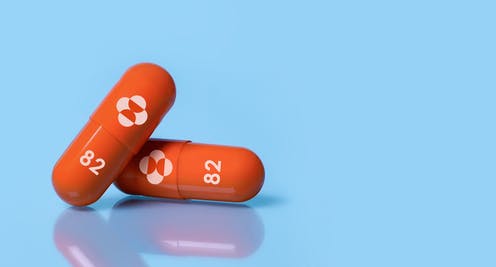StanislavSukhin/Shutterstock
If you’re worried about COVID, there’s a simple way to boost protection: get vaccinated. But this doesn’t work for everyone. People with weak immune systems – perhaps because of age or a medical condition – don’t respond well to vaccines. For them, COVID still poses a significant risk.
But in November 2021, the UK approved a new drug for treating COVID, reducing this risk. Called molnupiravir, it can be taken orally at home. It’s been authorised for treating mild to moderate COVID in adults – specifically those at high risk of developing severe illness.
Data suggests the drug cuts the risk of hospitalisation or death by 30%, which could make a big difference to people with little immunity. The UK government estimates it could save thousands of lives once fully available across the NHS.
However, some have argued that the drug should be tested further before being widely deployed, citing potential safety issues. The Indian Council of Medical Research, for example, has excluded the drug from its COVID treatment guidelines for this reason. This is all to do with how the drug defeats the virus.
How molnupiravir works
To reproduce, the coronavirus infects our cells and hijacks them. Once inside a cell, the virus gives the cell its own genetic instructions, ordering the cell to produce proteins that allow the virus to function. One is RdRp, which helps make more copies of the virus’s genetic material (its RNA), allowing for self-replication.

/Shutterstock
RdRp constructs copies of the virus’s genetic material from nucleotides – molecules that are the building blocks of RNA. Molnupiravir competes with the ordinary nucleotides to be used as building blocks by RdRp. When a molnupiravir molecule is used instead of a nucleotide, this introduces a mistake in the new RNA. This mutated RNA is then used as a template for making more RNA copies, with molnupiravir again being incorporated.
This leads to a build-up of mutations in the new copies of the virus. The occasional mistake can be tolerated when RNA is copied, but molnupiravir brings the rate of mutation beyond a biologically tolerable threshold. When so many corruptions stack up, the virus ends up not being able to reproduce altogether.
What are the concerns about?
Molnupiravir specifically targets the virus’s RdRp rather than our native biological machinery. This is very important: if our own cells also incorporated molnupiravir when making new genetic material, this could be highly dangerous. Molnupiravir has therefore been through trials to check its safety. Its first testing in humans checked the safety and tolerability of different doses as well as how the drug behaves in the body.
Some participants received single doses of up to 1,600 mg, others daily doses of between 50mg and 800mg across 5.5 days, and others a placebo. The most common adverse event for single-dose participants was a headache, affecting 13% of people, although headaches were actually more common among those receiving a placebo, affecting 19%. Among multiple-dose participants, the most common reported side-effect was diarrhoea – although this occurred at the same rate among those taking the placebo (affecting 7% of people in each case).
No clinically significant or serious adverse effects related to the drug were seen. Later human trials that gave the drug to over 700 people also recorded no major adverse events associated with the drug.
However, Rick Bright, formerly head of the US Biomedical Advanced Research and Development Authority, has alleged that “similar experimental drugs in this class had been shown to cause reproductive toxicity in animals, and offspring from treated animals had been born without teeth and without parts of their skulls”.
But other scientists have countered these concerns. George Painter, a chemist at Emory University, played a lead role in discovering the antiviral before it was licensed to the pharmaceutical company Merck. “We haven’t seen robust evidence for any sort of mutagenicity as had been seen in the past,” he says. He also points out that regulatory bodies evaluated the drug and gave approval for testing in healthy humans.
The drug has, though, been shown to increase the rate of mutation in mouse cells. However, Merck suggests there are extensive differences between these lab tests and testing that’s taken place in animals. Merck emphasises that these concerns haven’t been backed up in testing that’s more comparable to how the drug would be used medically.
How is the drug being used?
If a medicine is thought to be mutagenic, this danger can be mitigated by keeping treatment short. And generally, such drugs aren’t recommended to pregnant women or to men and women who are considering having a baby.

nerudol/Shutterstock
Indeed, the UK health regulator doesn’t recommend using molnupiravir during pregnancy and emphasises that women be careful not to conceive during treatment. It cites the lack of data on using the drug in pregnancy and a study in pregnant rats that showed that high doses (eight times the equivalent recommended human dose) led to foetal abnormalities.
Merck also includes the results of this study in its fact sheet for the drug, and states that “molnupiravir may only be prescribed to a pregnant individual after the prescribing healthcare provider has determined that the benefits would outweigh the risks for that individual patient”.
Molnupiravir is an easily administered and potentially lifesaving drug. By carefully balancing any potential risks and benefits, its responsible and beneficial use can hopefully be achieved. Concerns over safety must be taken seriously. Ongoing testing will help clarify how it can best be used from here on.
As of March 3 2022, the World Health Organization (WHO) has approved molnupiravir for treating non-severe COVID in people who are at high risk of being hospitalised. Acknowledging the safety concerns, and the need for further data, the WHO recommends “active monitoring for drug safety, along with other strategies to mitigate potential harms”.
![]()
Oliver Rogoyski does not work for, consult, own shares in or receive funding from any company or organisation that would benefit from this article, and has disclosed no relevant affiliations beyond their academic appointment.











